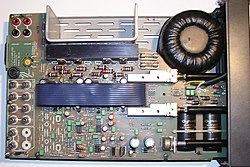Audio power amplifier
This article needs additional citations for verification. (April 2019) |


An audio power amplifier (or power amp)
The preceding stages in such a chain are low-power audio amplifiers which perform tasks like
While the input signal to an audio power amplifier, such as the signal from an electric guitar, may measure only a few hundred
History

The audio amplifier was invented around 1912 by Lee de Forest. This was made possible by his invention of the first practical amplifying electrical component, the triode vacuum tube (or "valve" in British English) in 1907. The triode was a three-terminal device with a control grid that can modulate the flow of electrons from the filament to the plate. The triode vacuum amplifier was used to make the first AM radio.[2] Early audio power amplifiers were based on vacuum tubes and some of these achieved notably high audio quality (e.g., the Williamson amplifier of 1947–9).
Audio power amplifiers based on
The
In the 2010s, there are still audio enthusiasts, musicians (particularly
Design parameters

Key design parameters for audio power amplifiers are frequency response, gain, noise, and distortion. These are interdependent; increasing gain often leads to undesirable increases in noise and distortion. While negative feedback actually reduces the gain, it also reduces distortion. Most audio amplifiers are linear amplifiers operating in class AB.
Until the 1970s, most amplifiers used
The Class-D amplifier, which is much more efficient than Class AB amplifiers, is now widely used in consumer electronics audio products, bass amplifiers and sound reinforcement system gear, as Class-D amplifiers are much lighter in weight and produce much less heat.
Filters and preamplifiers
Since modern digital devices, including CD and DVD players, radio receivers and tape decks already provide a "flat" signal at line level, the preamp is not needed other than as a volume control and source selector. One alternative to a separate preamp is to simply use passive volume and switching controls, sometimes integrated into a power amplifier to form an integrated amplifier.
Power output stages
The final stage of amplification, after preamplifiers, is the output stage, where the highest demands are placed on the transistors or tubes. For this reason, the design choices made around the output device (for single-ended output stages, such as in single-ended triode amplifiers) or devices (for push-pull output stages), such as the Class of operation of the output devices is often taken as the description of the whole power amplifier. For example, a Class B amplifier will probably have just the high power output devices operating cut off for half of each cycle, while the other devices (such as differential amplifier, voltage amplifier and possibly even driver transistors) operate in Class A. In a transformerless output stage, the devices are essentially in series with the power supply and output load (such as a loudspeaker), possibly via some large capacitor and/or small resistances.
Further developments
For some years following the introduction of solid-state amplifiers, their perceived sound did not have the excellent audio quality of the best valve amplifiers (see
TIM did not appear at steady state sine tone measurements, helping to hide it from design engineers prior to 1970. Problems with TIM distortion stem from reduced open loop frequency response of solid-state amplifiers. Further works of Otala and other authors found the solution for TIM distortion, including increasing slew rate, decreasing preamp frequency bandwidth, and the insertion of a lag compensation circuit in the input stage of the amplifier.[10][11][12] In high-quality modern amplifiers the open loop response is at least 20 kHz, canceling TIM distortion.
The next step in advanced design was the Baxandall Theorem, created by Peter Baxandall in England.[13] This theorem introduced the concept of comparing the ratio between the input distortion and the output distortion of an amplifier. This new idea helped audio design engineers to better evaluate the distortion processes within an amplifier.
Applications

Important applications include
Power amplifiers are available in standalone units, which are used by
and car stereos have power amplifiers integrated inside the chassis of the main product.See also
- FET amplifier
- Instrument amplifier – Amplifier with loudspeaker for use with musical instruments
- OCL amplifier
- Push–pull output
- Single-ended triode
- Tone control circuits
References
- ^ "1 – Integrated Amplifier (All Versions)". Archived from the original on 2011-04-24. Retrieved 2011-01-16. Cyrus Audio: Product Archive: Cyrus One
- ^ The Transistor in a Century of Electronics. nobelprize.org
- Electronic Design. 21 April 2017. Retrieved 23 July 2019.
- ^ ISBN 9780080508047.
- ISBN 9780750626293.
- ISBN 9780793524112.
- S2CID 13952562.
- ^ Jung, Walter G.; Stephens, Mark L. and Todd, Craig C. (June 1979). "An overview of SID and TIM". Audio.
{{cite journal}}: CS1 maint: multiple names: authors list (link) - Journal of the Audio Engineering Society. 20 (5).
- Journal of the Audio Engineering Society. 28 (5).)
{{cite journal}}: CS1 maint: multiple names: authors list (link - Journal of the Audio Engineering Society. 28 (3).
- ISBN 978-0-7506-0868-8.
- ^ Baxandall, Peter (February 1979) "Audio power amplifier design" Archived 2022-06-09 at the Wayback Machine, Wireless World magazine
